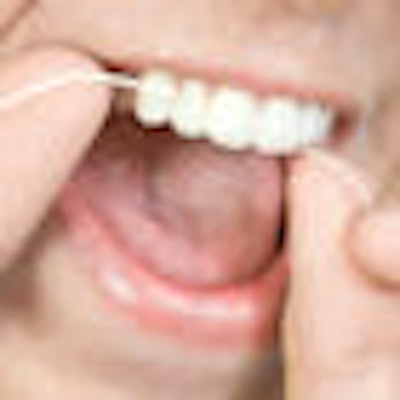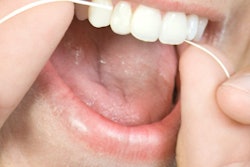
Floss, floss, floss! Dentists and their staff spend a lot of time driving that simple message home to their patients. But what if it's too simple? What if it's not doing any good at all? Those are the conclusions reached in a new study.
"A routine instruction to use floss is not supported by scientific evidence," wrote researchers from the Academic Centre for Dentistry Amsterdam in the Netherlands in the International Journal of Dental Hygiene (November 2008, Vol. 6:4, pp. 265-279).
It's not that flossing can't work when done right, the researchers wrote. But after looking at all the published papers they could find, they concluded that most patients don't bother, or do such a lousy job that they don't get any benefit -- even after being instructed.
Not everyone is ready to accept these findings, however. "When you floss, you can eliminate most of the bad bacteria and allow normal bacteria to recolonize the mouth," said Patricia Corby, D.D.S., an assistant professor at the New York University College of Dentistry.
The Amsterdam researchers searched Medline (the U.S. Library of Medicine) and the Cochrane Library, and found 1,353 papers that measured whether flossing reduced plaque and gingivitis.
They focused only on randomized controlled trials in which some patients both flossed and brushed while others only brushed, leaving them with 11 studies. Overall, the data showed that patients who added flossing to their dental hygiene did not get statistically significant improvements in reducing either plaque or gingivitis.
Flossing can remove plaque, the researchers conceded. They cited one study finding that children had less risk of caries when their teeth were professionally flossed (Journal of Dental Research, April 2006, Vol. 85:4, pp. 298-305).
But "research also shows that few individuals floss correctly" when left to themselves, they wrote.
So should you give up on getting your patients to floss? Not at all, argued Dr. Corby. "Education is the key," she said.
In August, Dr. Corby and colleagues published a study in the Journal of Periodontology (July 2008, Vol. 79:8, pp. 1426-1433) that involved 51 matched pairs of twins. Those who flossed and brushed had less harmful bacteria in their mouths than those who merely brushed.
In an earlier report on the same study, the team showed that the flossers had less gingival bleeding as well.
Dr. Corby said that if the Dutch researchers had included this study in their review -- and a couple of other large ones -- they would have found an overall benefit for flossing. She argued that the study she helped run was particularly important because by comparing twins it eliminated genetic and environmental factors that could otherwise confound the results.
The Dutch researchers did not respond to DrBicuspid.com's request for a comment. But the text of their article suggests why they excluded Dr. Corby's study from their review. In her study, as in many of the others in which flossing was shown to work well, professionals watched over the patients as they flossed.
"The Council on Scientific Affairs of the ADA suggests that interdental cleaning devices should be evaluated 'under unsupervised conditions,' " the Dutch researchers wrote.
In real life, of course, you can't drop in and watch your patients floss every day. You can still make a difference by teaching patients that they should think of floss the same way they think of a toothbrush -- as a tool for cleaning every tooth, not just for removing pieces of food they can see or feel, according to Dr. Corby.
"You really need two minutes to do the whole mouth," she said. Which means you probably need even more time to teach each patient how to floss.
Will that work in your practice? "Studies are inconsistent in their ability to demonstrate that educational attempts to influence floss frequency can be successful," the Dutch researchers wrote.
But they acknowledge that research alone cannot answer all the answers for an individual clinician. Their ultimate advice: Figure out which of your patients -- if any -- are motivated and disciplined enough to follow detailed flossing directions.


















